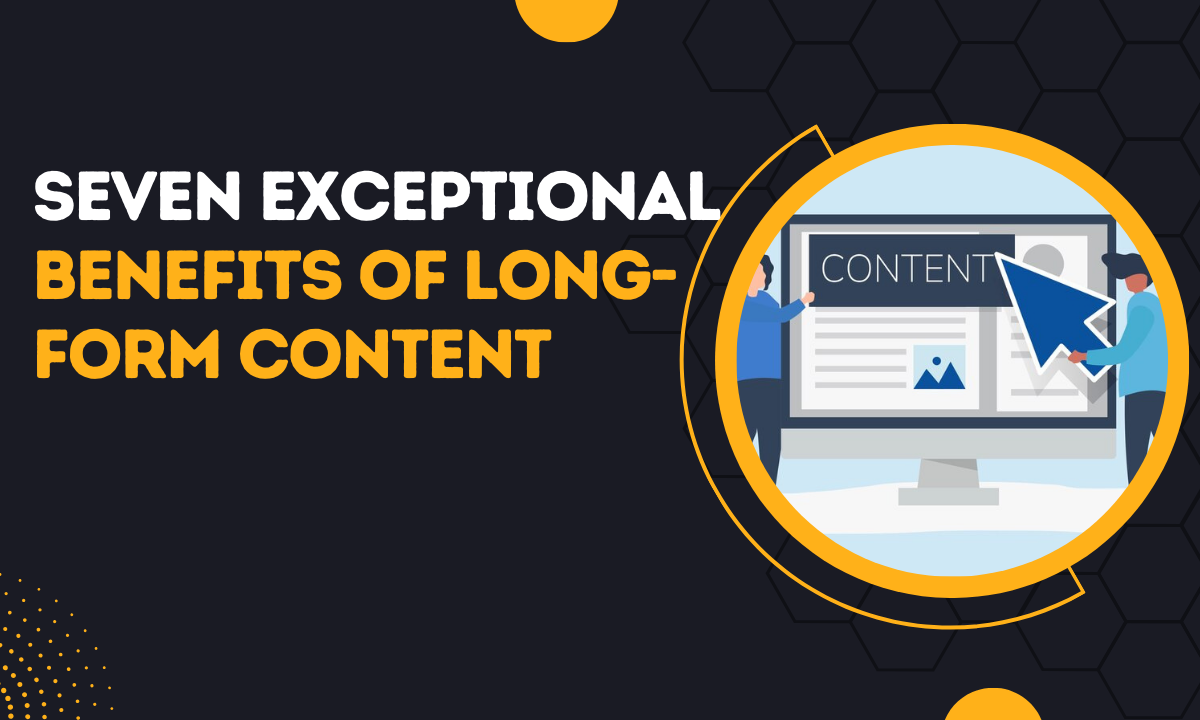7 Exceptional Benefits Of Long-Form Content
The benefits of long-form content are often overlooked by bloggers because of a pure lack of awareness. Increasingly, over the years, long-form content has become the holy grail for bloggers and search engines.
Creating long-form content is laborious work. That’s why bloggers are constantly looking for easier solutions and alternatives.
That’s also why, since the early days of blogging, statistics have been piling up about ideal blog lengths.
so what’s the popular question about the content?
You guessed it…
“Do we create long detailed posts or short ones?”
The answer is not that simple, because there’s a catch.
Guess what?
Reader attention spans are shrinking. Online readers are impatient and want to read less.
Yet, surprisingly longer posts seem to rank higher on search engines.
What a strange contradiction.
Isn’t that quizzical?
That’s what we’ll try and understand in this post. And also the benefits of long-form content.
The fact is, that despite the apparent contradiction, there are a couple of reasons why longer posts rank better.
And if you understand the reasons behind long, wordy posts, I’m sure you’ll also grab some of their benefits.
One of the consistent observations by SEO wizards is that longer content grabs higher user-engagement and more backlinks.
Now that’s a huge payoff.
And that’s not all. There’s much more to these advantages.
But before going into the benefits of long-form content, what is long-form content?
Let’s dive in.
Table of Contents
ToggleIs Long-Form Content Only About Length ?
Long-form content is that which is detailed, long, and delivers epic value.
It offers a ton of information and massive in-depth insight into a subject.
In the initial days, it was considered that any content above 300 words qualified for long-form. But today this count has increased almost 10X.
Effectively, this kind of content is definitely that – L.O.N.G!
Matter of fact, a word count anywhere between 2000 and 2500 words is a commonly accepted long-form content.
However, word count itself is not a rigid definition of long-form content.
Before any word count starts concerning you, your content firstly has to be comprehensive and contextual.
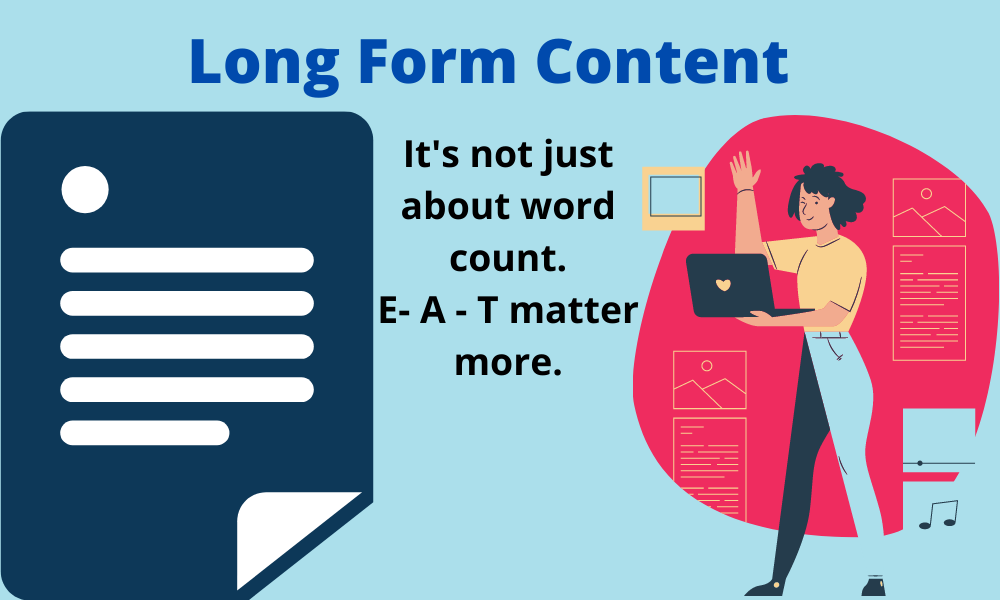
Neil Patel of neilpatel.com says that long-form content should effectively have three attributes:-
✔It should be deep.
✔Must be comprehensive.
✔It should be keyword focussed.
But I would go onto add that it should also convey the famous “ E-A-T” aspects
▪Authority
▪Trustworthiness
In spite of these demanding factors at the center, today we have long-form content that ranges anywhere from 3000 to 10000 words!
Can you imagine writing 10000-word posts, day after day?
It’s tedious-serious business, to say the least!
And if it’s not done right, then creating such gargantuan content amounts to nothing. You’re unlikely to gain any benefits of long-form content.
What a sheer waste of time.
But for the saving grace of the factors mentioned above.
Yet, for obvious reasons, we’re not studying content creation methods in this post. We only want to grab the benefits of long-form content.
Still, its possible you’re wondering “what’s the easier alternative to long-form content?”
It’s only natural that most content creators are stumped by this dilemma between the two forms
So what’s the solution?
We’ll get to that. But before that ….
Lets take a brief look at the dilemma between long-form and short- form content.
Why Long-form And Not Short-form?
Well firstly, there aren’t any strict delineations between long-form and short-form content, based on the word count alone.
But it’s a commonly accepted fact that any content up to 1200 words is the short form. And anything that’s 2000 words and beyond, belongs to the category of long-form content.
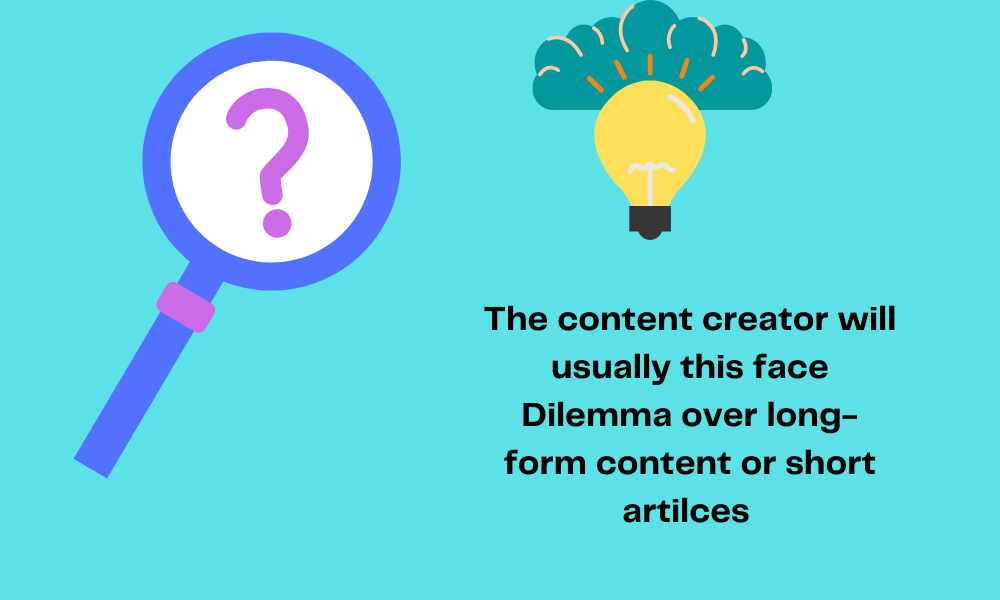
Still ( I’m repeating myself ) word count alone doesn’t qualify.
What will eventually save you is depth, comprehensive content and E-A-T (expertise, authority,trust).
I’ve said this before, and you just can’t miss it…
A lot of readers are simply not into long-form content. They are in a hurry for quick, bite-sized information to run along with.
And if your readers are too absorbed by short-form stuff like Twitter or Buzzfeed then they won’t read your long, detailed posts.
Whatever you may do.
But statistics tell you that long form content far outranks short form, and that it’s even good for your long term success.
Now that’s a dilemma. Isn’t it?
What do you do?
In such situations, all you do is test out your content lengths against audience engagement.
It’s possible that unwittingly you’re pandering to an audience that may be hooked to short-form content.
That’s why despite your epic content you may not be making great progress. Hence you won’t get the sought-after benefits of long-form content. So the solution lies in listening to what your tests tell you.
But that’s not all.
You can do a bit more to deal with the situation….
Resolve That Content Dilemma
While we cannot have a one-size-fits-all strategy for content, there are three aspects that help you decide better; user intent, target audience, and marketing objectives.
User Intent .
It very essential to ask why the user has landed on your site.
What is the reader’s keyword intent ?
In fact, the keyword intent of your readers reveals an immense lot.
At the very least you will be able to answer this…
Is it possible to convert with short-form content itself? Or can you succeed with long form content?
Target audience.
Why is target audience important?
Here’s why.
They’re the ones for whom you’re creating content. Period.
So you would serve yourself well to do some target audience research .
What does that involve?
Well, you simply examine a few stats and demographics of your target audience. What are their educational and professional backgrounds?
Are they tech- savvy folks, who’re into short-from media like Instagram, Pinterest, Twitter?
Or are they in positions of long-term decision making? Do they prefer a detailed evaluation?
Also, make sure you outsmart the competitors in your choice of content types
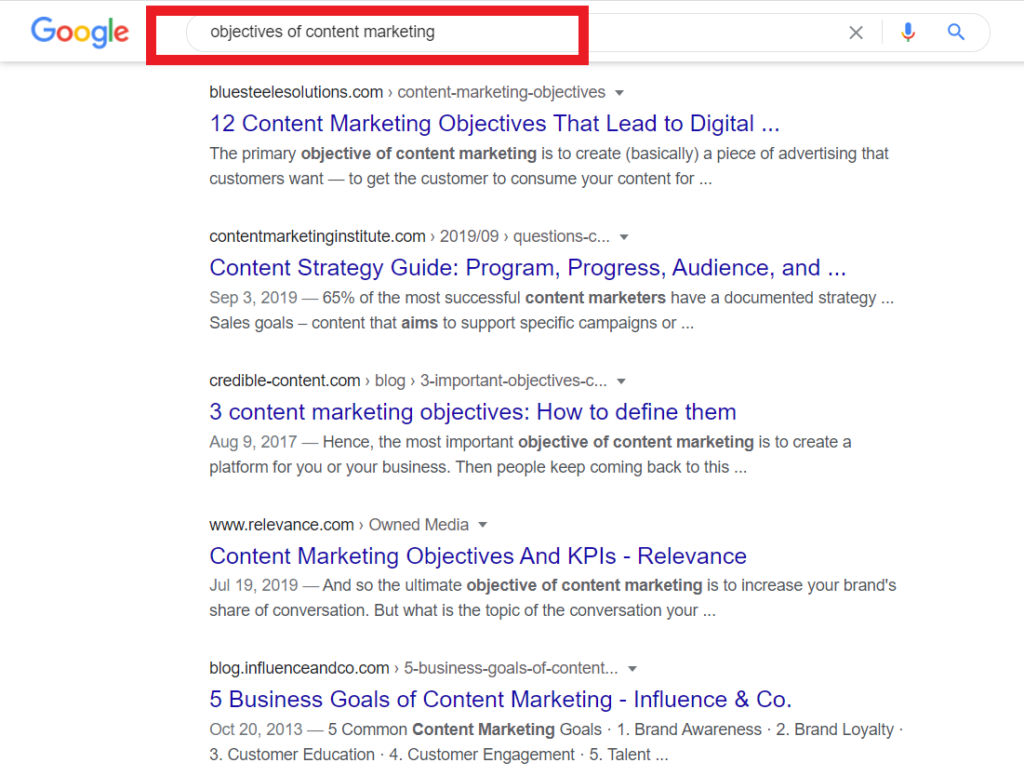
Marketing Objectives.
If your goal is to enhance brand awareness quickly, then short-form content will do well.
But if you want long term customers to revert to you for recurring needs, then long-form content is the way to go. Eventually, you will see steady benefits of long-form content coming in.
Looks like some pretty uphill work, but bear with me.
To clear the fog, let’s take a peek at some examples of long-from content first.
Examples of Long-form Content
So far we’ve gone over this already right?…
That long form content is one that has a word count of 2000 -2500, or more.
But it is more important for that content to have substance, context, and be purpose-driven.
Above all, readers must find it useful.
But what does long-form content look like?
Well, it comes out in various forms.
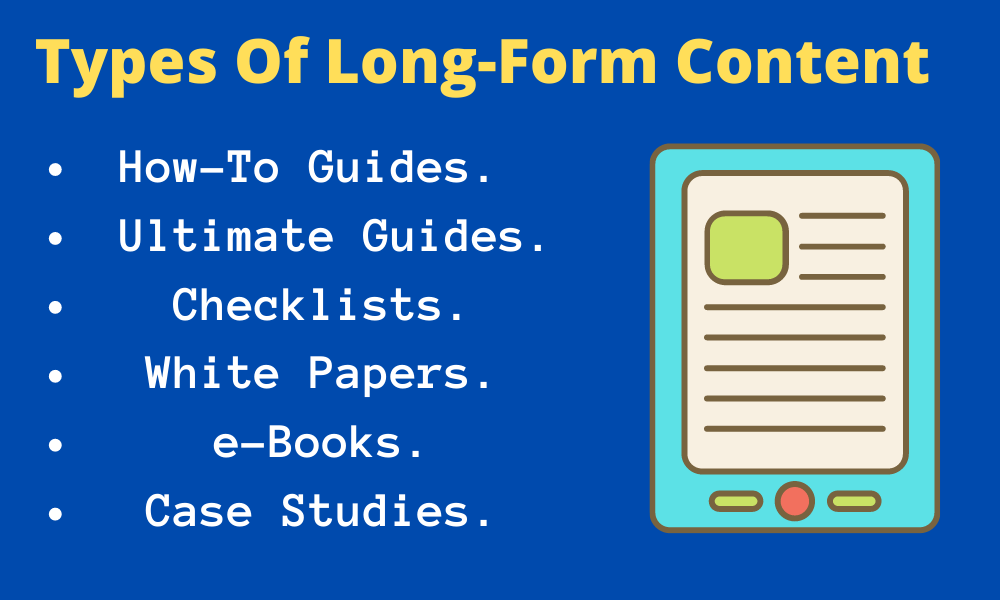
Take a look at a few commonly known long-form contents:-
How-To Guides. These are detailed instructions of immense value. How? Because they teach you to actually accomplish a specific task or project in a step by step manner.
Ultimate Guides. Guides such as these are invaluable for readers who are desperate to resolve immediate problems. What’s more? Usually, readers will readily spend a lot of money to lay hold of such information.
Detailed Checklists. These are actionable checklists for accomplishing complex tasks. For a specific topic, they’re an immense resource that readers will utilize repeatedly to organize their projects.
White Papers This is unique content that’s dense with insights, it offers solutions and data on a particular subject. The emphasis of a white paper is on all the details of that topic.
e-Books. ebooks are definitely long-form. And because they offer unique value, they make excellent lead magnets. It’s even better if they have evergreen content. Over time ebooks have consistently brought the most benefits of long-form content.
Case Studies. When you do a sequential analysis of a specific situation, great deductions emerge, that help in future decision making. Such action-based insights make case studies. And they provide both, long term comprehension and actionable information. You can rely on this knowledge for future decision making in similar situations.
Benefits of Long Form Content
Comprehensive Content Brings Higher Google Rankings
Google has stressed one thing consistently. And that is their simple objective.
It is that online users should be quickly able to access comprehensive information.
Can we ignore what Google itself intends?
Here’s the interesting thing…
In 2015 HubSpot conducted a study. They analyzed a total of 6,192 blog posts on their Hubspot Marketing blog.
In fact, they specifically studied the correlation between high performing pages with organic search and their word count.
And what was the finding of the study?
That word counts over 2250 drove lots of traffic.
Further along , they discovered an even better sweet spot. That is articles with a word count between 2250 and 2500 receive most organic traffic.
Then take the example of Backlinko.com
Backlinko did another independent study.
They discovered something pretty hard to believe at that time.
In fact, they had evaluated one million Google search results to find out the best SEO practices today. Surely their finding was contrary to a lot of expectations….
And what was the finding ?
“That long-form content ranked significantly higher in Google’s search results consistently”.
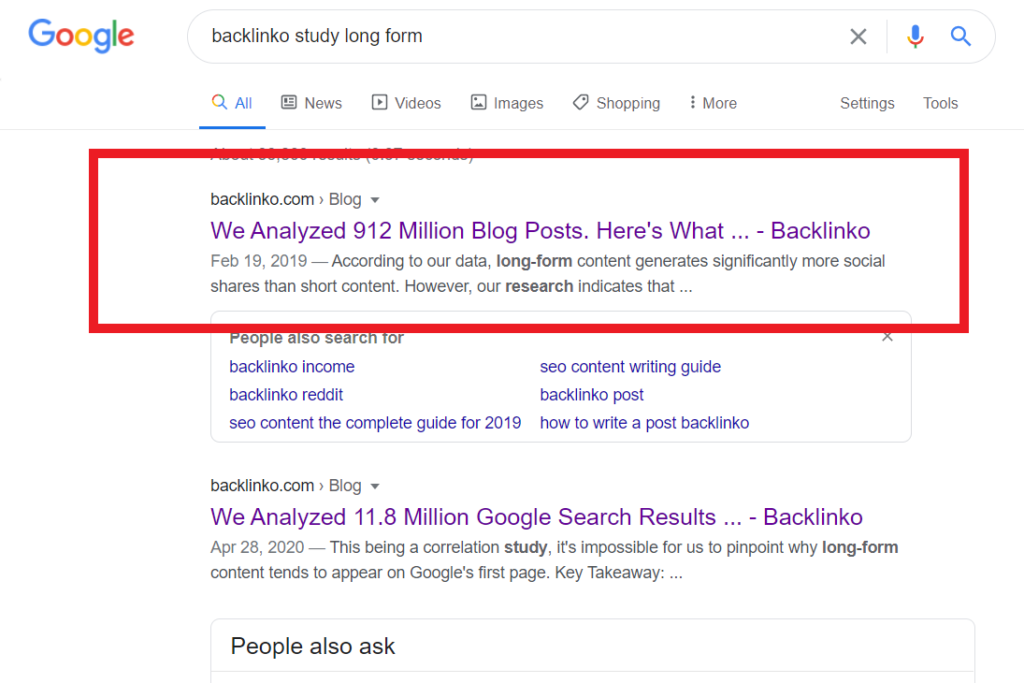
But that’s not all.
There’s another payoff.
Let’s take a hypothetic situation……
Suppose (for discussion sake) you don’t receive any backlinks for your long-form content. The interesting fact is, even then it will still rank high for low-competition long-tail keywords .
That’s because long-form content continues to boost your content relevancy and brand authority. That’s the inherent virtue in long-form content. These are matchless benefits of long-form content, anyone would envy.
That brings us to the next point. Traffic.
Long Form Contents Benefits Backlinks And Organic Traffic
There’s tons of statistics that show the tangible benefits of long-form content.
Recollect the Backlinko study?
Well, according to them long-form content gets an average of 77.2% more links than shorter articles.
But why exactly is that?
The fact is that among other things the aim of long-form content is also to reach out to influencers. The idea is to create exceptionally great content so that other sites are compelled to link back to you.
And now you’re thinking “where’s the evidence of all this?”
This is exactly what BrianDean of Backlinko proved through a long-from article, which doubled his blog traffic in 14 days.
Why?
Because long-form content tells your readers that detailed content is better than whatever else is out there.
And then your readers simply can’t resist sending out those likes, shares, and backlinks.
Let me explain.
The famous blog, Quick Sprout, proves that posts longer than 1500 words receive 68% more tweets and 22% more Facebook likes.
Here’s the interesting part.
Today Google is penalizing sites that link back to low authority pages. Consequently, everyone wants to link out to high-quality content.
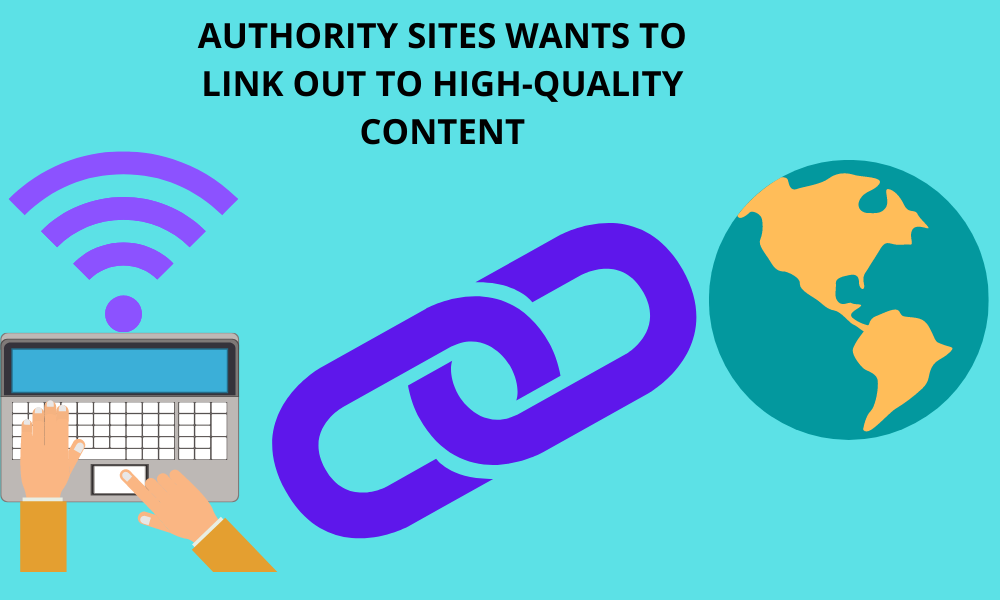
Now if high authority sites start linking out to you,it simply accelerates your SEO rankings.
But why would authority sites link out to you?
Because you create killer content. That’s why.
And well researched and crafted, long-form content conveys just that to search engines!
More importantly, today many brands are on the lookout to enhance their SEO. So they constantly search for authority sites to link with their content.
You must be wondering where you figure in this?
Well, you could be this authority site in your niche by generating exceptional long form content. Then slowly watch how other sites reach out and link up with you. So over some time, the benefit turns cumulative!
But wait, that’s not all. It gets better.
Did you know long-form content is excellent for social sharing?
Sharing Long Form Content On Social Media
After analysing 100 million posts, Buzzfeed concluded that long form content invariably attracts more shares.
However most brands only end up publishing 500-800 word content, but that has almost turned cliché. Search engines and readers are not fascinated by such predictable stuff anyway.
Then what do you do to grab attention?
You guessed it.
Comprehensive, in-depth articles are the best answer.
So you’ve got be focussed on creating long-form content which brings long-lasting benefit for the reader.
When readers see you consistently offering long-form content that is best in the industry, they will eventually share it. As we said earlier, the payoff is that you’re likely to get 68% more Tweets and 22% more Facebook likes. With the rising importance of social signals for your ranking, I think that is an unrivaled benefit of long-form content.
Ok, so your content is drawing lots of traffic and social shares. But what does that imply for your brand?
Brand Credibility and Authority : True Benefit Of Long-Form Content
The greatest benefit of well researched long-form content is that it’s a powerful tool to build your brand credibility. It is the best solution for proving that your site is a reliable source of useful information.
It also establishes your authority.
And what does that mean?
It means that credible and authority sites earn prospects’ confidence.
Case in point. Neil Patel.
At one point Neil Patel authored a guide to growth hacking called “The Definitive Guide To Growth Hacking”.

This is a 10 chapter long detailed document that explains complex topics like push/pull tactics, growth hacker funnels, and user retention. Most importantly, it offers actionable techniques that online readers can apply to real-life enterprise.
Sounds complicated. But stick with me because of the gains.
It turned out that despite the voluminous content, it got an amazing response. That’s because the information was exceptionally detailed and comprehensive for the reader.
End result?
Neil’s authority status was further reinforced.
This is the inspiring stuff that legends made of. By the way, this is just one success story among hundreds of others, but it just goes to prove the incredible benefit of long-form content.
Creating a detailed, in-depth chunk of content will inevitably mark you as a thought leader in your domain. You’re bound to succeed.
In fact, this success has “happened” to whoever has adopted the right content route consistently.
On top of that, if such long-form content is evergreen then you showcase your brand as an authority in that realm.
You’ll agree with me that your readers will quickly get the point…
That you are not a fly-by-night marketer. And your content delivers just superb value.
Your reward?
Brand loyalty.
How awesome is that?
Benefit of A More Sustainable Content
Most evergreen, sustainable long-form content has hidden advantages, which means it:-
✔ Generates leads for a long time
✔Keeps you in the public eye for a long time.
✔Ranks well in search engines.
✔Is not seasonal or event-based.
✔And it’s something that your readers miss.
Now just in case, you’re curious…
A few examples of evergreen formats are:-
▪ FAQs.
▪ Industry definitions.
▪ How to guides
▪ Unchanging industry stances
▪ Resource lists
Yet in spite of the advantages, there’s a catch….
The catch is that long-form content is a more costly investment than shorter content. Whether in terms of time required for creating or budget for hiring content writers.
But in spite of that bump, the greatest benefit of sustainable content is its potential to drive organic traffic over the long term.
The longer it remains published the better it is for the site. Because once your content grows popular, the constantly returning traffic will automatically enhance site rankings.
Most importantly, evergreen content lowers the bounce rate and greatly helps create backlinks.
That’s why, long-form evergreen content is considered a true differentiator that singles out your brand from the pack.
It has enormous potential to generate “business fertility” for extended periods— offering the best returns on investment.
Initially though, creating that long-form content may appear to be an enormous time and money sucker.
But…….
The long term benefits are worth every ounce!
Longer Dwell Time
Dwell time is a function of the time spent by users on your site.
Its an important metric.
Let me elaborate….
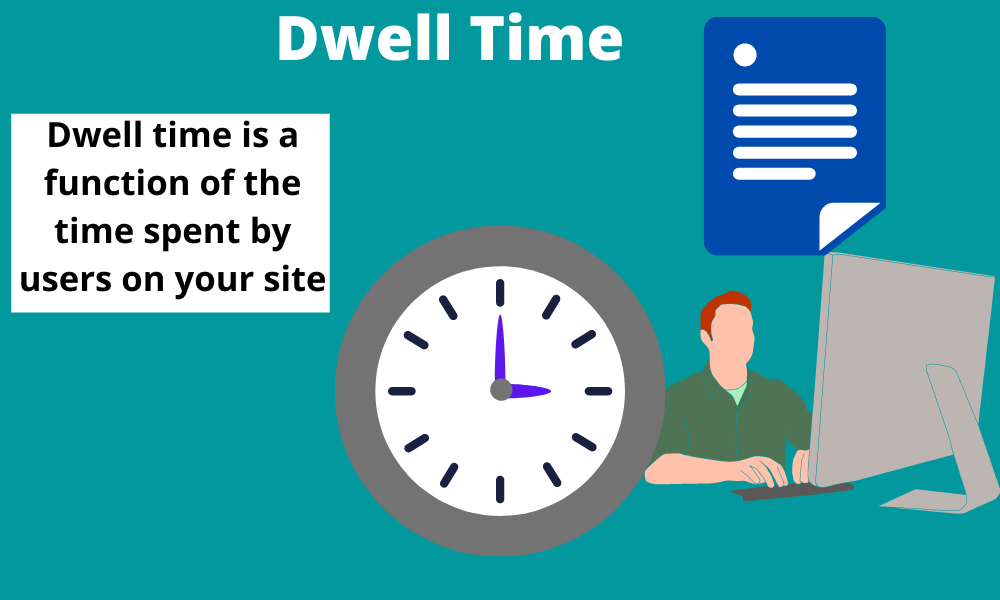
Just in case you’re new to this, Google search engine operates through complex software algorithms that decipher the heck out of everything. One such favourite algorithm of Google is called Rankbrain. And Rankbrain is quite fond of dwell time.
And now you’re thinking what’s this?
Well, the longer Google notices readers staying or “dwelling” on your pages the better your ranking is.
So how do you increase that dwell time?
You guessed it.
With valuable, long-form content.
The more engaging, long-form content you publish, the more the reader is pulled in to your page.
But a mere mountain of content won’t do. It must deliver exceptional value.
Exceptional value is a huge pie to focus on in the content space.
Here, let me lift the veil for you a bit…
As web analysts study ranking trends, it’s becoming increasingly clear that besides the length, exceptional content has three main facets. It:-
1. Is insightful.
2. Has wide area coverage.
3. Is keyword centered.
So how do you nail dwell time?
Simply by sticking to the basics of long form content that’s engaging, and has all three angles covered.
Finally one of the lesser-known benefits of long-form content…
Reduced Inbound Marketing Costs
Now this is interesting.
How do you think usually marketing or sale takes place?
Invariably marketing starts with the seller initiating the process. He reaches out to the customer through some advertising or messaging, right?
This an example of an outbound business process. Here the seller is the first one to reach out to the customer and actively asks him to buy.
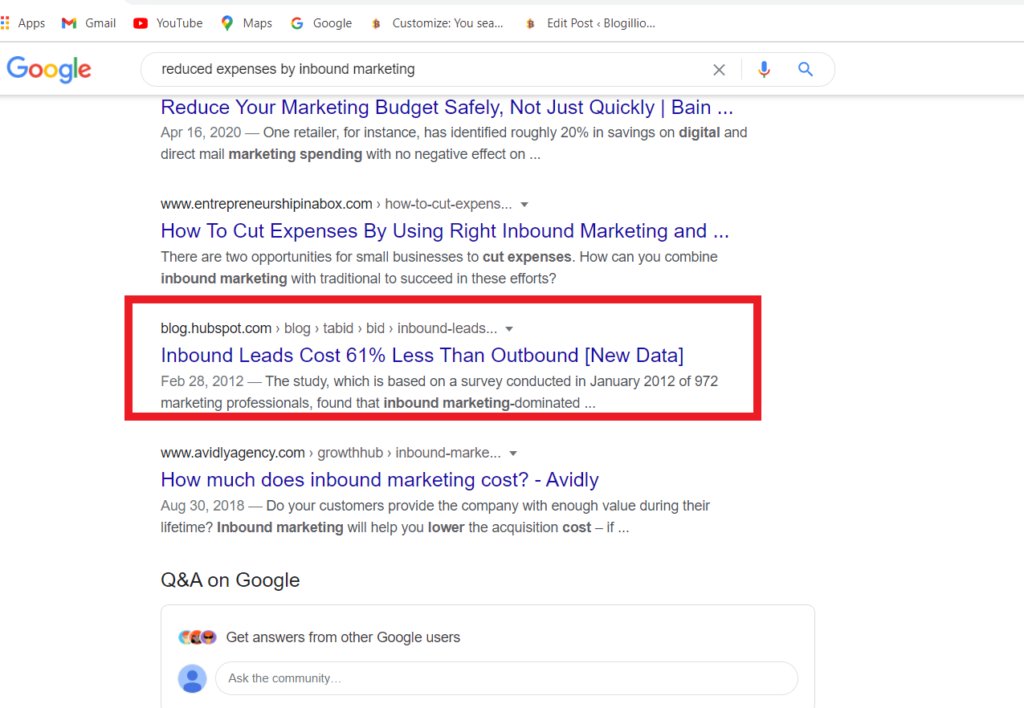
An inbound process is the opposite of this.
In the inbound process, the ‘customer calls in’ first.
Common examples of inbound processes are customer service or tech support.Notice, here customers call in to get their queries answered or issues resolved.
The “inbound marketing” business methodology works beautifully in the online content business too.
Here, you simply create killer content tailored to the customers’ pressing needs.
Next, the customer checks out your site.
He finds the content useful and predictably comes back for more.
During this process, at some point the customer shares his contact information, which is a long term gain. Meanwhile you continue serving him with exceptional long form content on your site. This way a customer becomes a loyalist for the invaluable content you initially offered him.
This is the essence of inbound marketing.
Well, what’s the benefit?
There’s one and only benefit. This form of marketing cuts down on your publicity and ad expenses enormously.
In fact, going by a HubSpot report, inbound marketing has saved an average of $20,000 annually for many brands.
Conclusion
A lot of websites are publishing exceptional content but continue to miss out on the strategic benefits of long-form content.
We simply cannot ignore Google’s algorithms like RankBrain that factor in metrics like dwell time.
Nor can we overlook the value search engines give to backlinks and shareability.
Surprisingly long form content inherently carries these benefits, besides the credibility and brand authority it injects in your site.
Usually, we consider long-form content as that which exceeds 2000 -2500 words, and more. But it’s wrong to depend on word count alone for the benefits of long-form content.
Rather it’s immensely important to spend some time on target research, market objectives and user intent.
Besides, your content must deliver depth, and be comprehensive.
Finally, don’t forget your keyword focus throughout.
Only after satisfying yourself on these “counts”, take a look at your “word count”!
That’s when..…
Longer content is truly better.
Wishing you luck with long form content.
What’s your opinion on long form content?
I Would be glad to see your comments.

